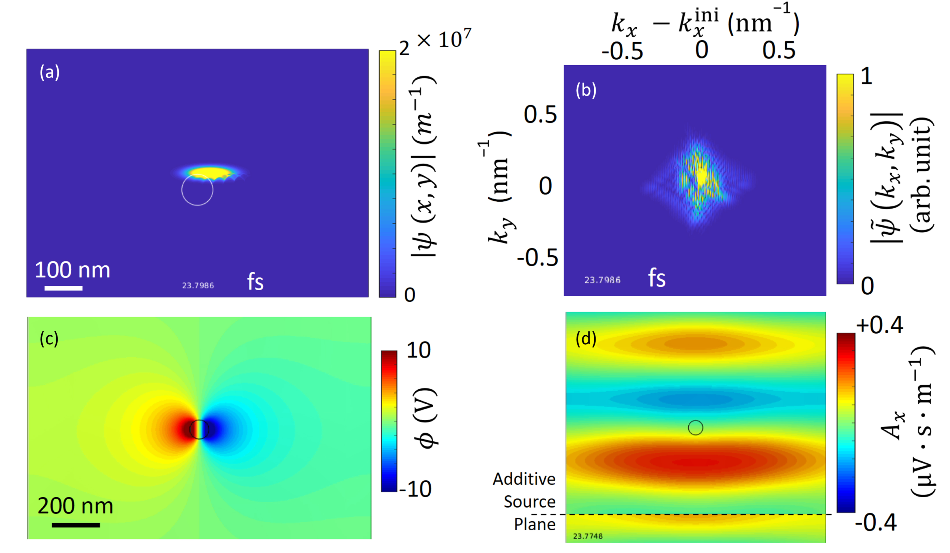Sep 1 2020
Electron microscopes offer the maximum possible spatial resolution of less than one-millionth of 1 mm, thus enabling the study of the characteristics of materials at the atomic level. This allows the demonstration of the realm of quantum mechanics.
 A snapshot of the simulations. The profile of the electron wavepacket in (a) real space and (b) reciprocal (momentum) space. (c) Scalar and (d) vector potentials of the electromagnetic field. Image Credit: Kiel University.
A snapshot of the simulations. The profile of the electron wavepacket in (a) real space and (b) reciprocal (momentum) space. (c) Scalar and (d) vector potentials of the electromagnetic field. Image Credit: Kiel University.
Specifically, the fundamentals of quantum physics can be investigated by studying the interactions between photons and electrons. When the electrons are excited using laser light, for instance, their mass, velocity, or energy tends to change.
A new toolbox, invented by Professor Nahid Talebi from the Institute for Experimental and Applied Physics at Kiel University, could now be used to extend the theoretical explanation for electron-light interactions with the maximum possible accuracy.
Professor Talebi combined Schrödinger and Maxwell equations in a time-dependent loop to completely simulate the interactions from first principles. For the first time, the simulation enables ultra-fast processes to be accurately described in theory and to map them in real-time without the need for applying adiabatic approximation.
She presented the study results recently Physical Review Letters, a renowned journal. In the long run, her findings could help optimize the microscopy technique as she is investigating in her ERC Starting Grant project “NanoBeam,” which is financially supported by the European Research Council.
The ultrafast electron microscopy is a combination of laser technology and electron microscopy. By using ultrafast electron pulses, researchers can investigate the dynamics of the sample at femtosecond temporal resolutions.
Moreover, this enables arriving at conclusions about the sample’s properties. With the further advancement of spectroscopy technology, it is now feasible to study not just the electronic and atomic structure of the samples but also their photonic excitations, like plasmon polaritons.
For the First Time, the Simulation Depicts the Process of the Interactions as a Film in Real-Time
However, it is time-intensive to simulate such electron-light-interactions, which can be performed only with high-performance computers.
Therefore, adiabatic approximations and one-dimensional electron models are often used, meaning that electron recoil and amplitude modulations have been neglected.
Nahid Talebi, Professor of Nanooptics, Institute of Experimental and Applied Physics, Kiel University
Talebi is an expert in simulations. This is the first time that her new simulation demonstrates the process of the electron-light interactions as a real-time film, depicting the complex interactions to the maximum possible accuracy.
Schrödinger and Maxwell equations have been combined in a time-dependent loop in Talebi’s toolbox to completely simulate the interactions from first principles. Thus, she has established the new field of electron-light interactions far from adiabatic approximations.
Using this combination, she could simulate what happens when an electron advances toward a gold nanostructure that had already been excited with a laser. The simulation demonstrates how the energy, momentum, and typically the shape of the electron’s wave packet change for each moment of the interaction.
Thus, Talebi was able to capture the entire dynamics of the interaction caused by both single-photon and two-photon processes. Single-photon processes are crucial, for instance, to model electron energy-gain and energy-loss channels. By contrast, two-photon processes help to model the laser-induced elastic channels, for example, diffraction phenomenon.
Specifically, in Talebi’s simulation, a distinct diffraction pattern originating from strong interactions between electrons and photons based on the Kapitza-Dirac effect could be observed. Such a diffraction pattern could find potential applications in time-resolved holography, to interpret the charge-carrier dynamics of molecular and solid-state systems.
Further Improving Spectroscopy Methods with ERC Project “NanoBeam”
Our toolbox can be used to benchmark the many approximations in theoretical developments, including eikonal approximations, neglecting the recoil, and neglecting two-photon processes. Although we already have made a great step towards electron-light interactions beyond adiabatic approximations, there is still room for further developments.
Nahid Talebi, Professor of Nanooptics, Institute of Experimental and Applied Physics, Kiel University
Along with her colleagues, she intends to incorporate a three-dimensional Maxwell-Dirac simulation domain to be able to model spin and relativistic interactions. In addition, she desired to gain better insights into the role of exchange and correlations in electron-electron interactions.
Talebi’s other goal is to apply the understanding gained from the theoretical modeling to develop innovative methodologies for coherent shaping and control of the sample excitations with the help of electron beams.
By using her “NanoBeam” project, she plans to create an innovative spectral interferometry technique that can retrieve and control a scanning electron microscope’s spectral phase to overcome the difficulties in achieving both nanometers spatial and attosecond time resolution. The project is financially supported by an ERC grant of around 1.5 million euros from the European Research Council.
Journal Reference:
Talebi, N. (2020) Strong Interaction of Slow Electrons with Near-Field Light Visited from First Principles. Physical Review Letters. doi.org/10.1103/PhysRevLett.125.080401.